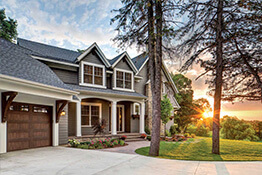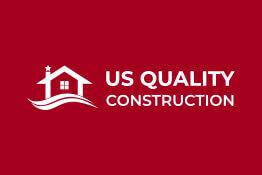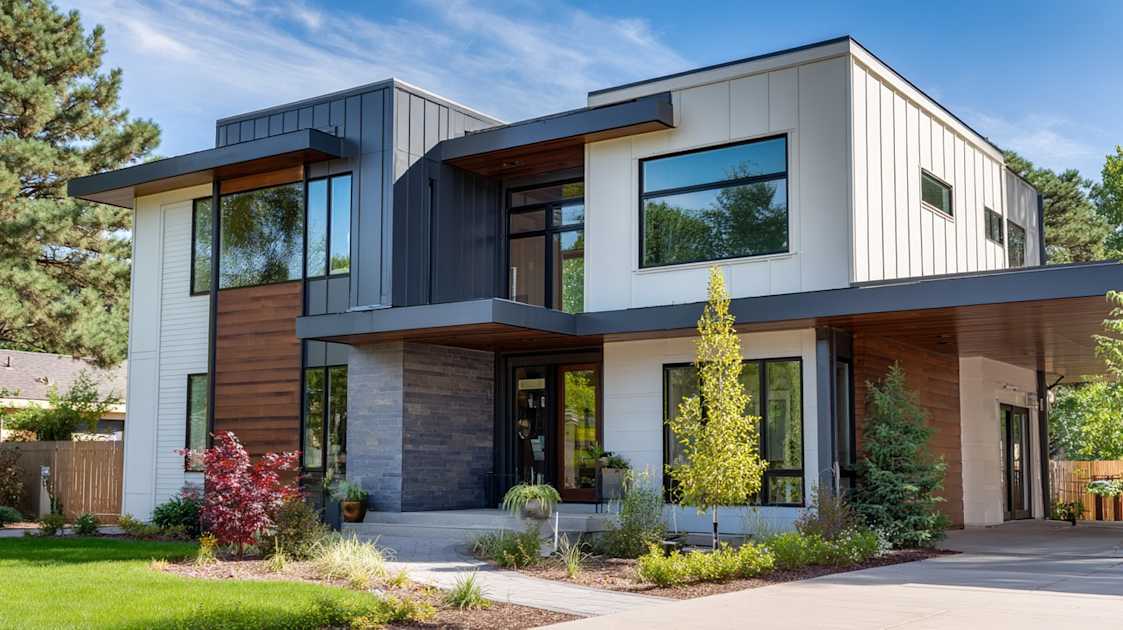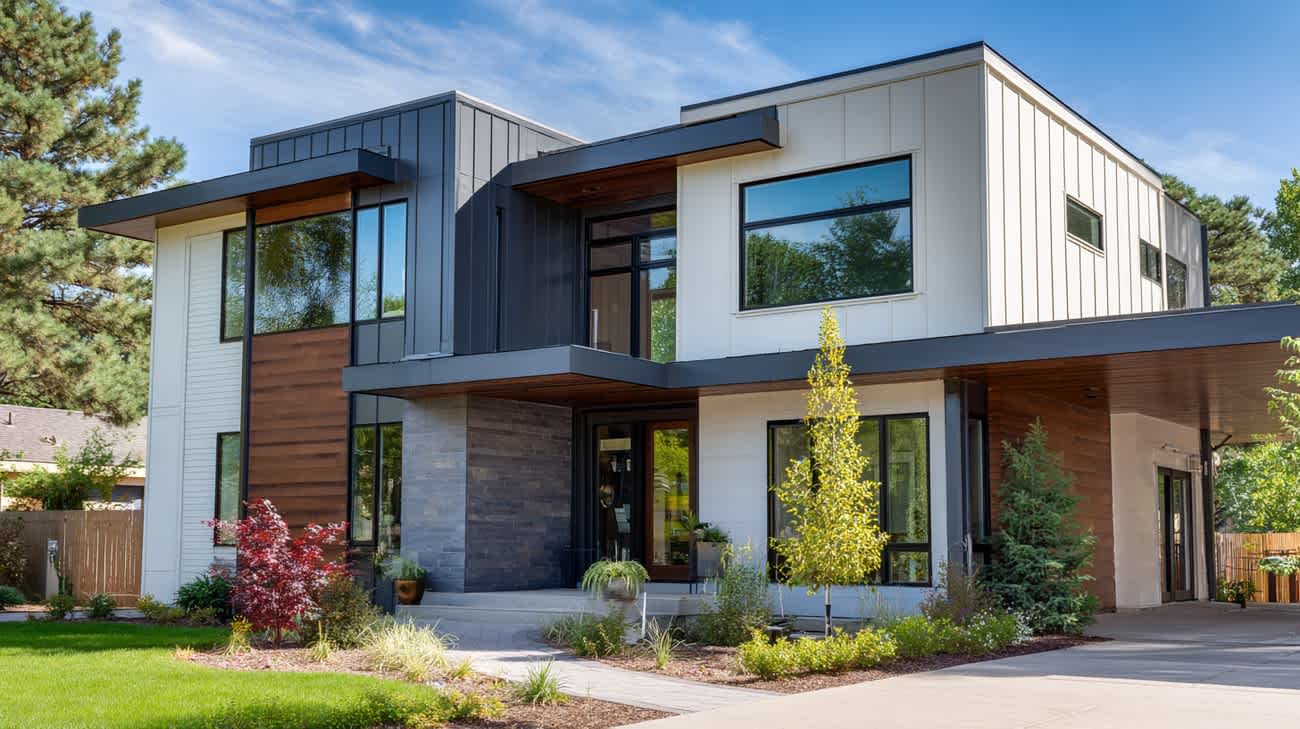When considering a home makeover, selecting the right siding can make all the difference in enhancing curb appeal and boosting property value. Among various options, James Hardie siding stands out as a favorite for homeowners due to its durability, aesthetics, and versatile styles. This comprehensive guide delves into the diverse James Hardie siding styles, helping you choose the perfect fit for your house.
What Makes James Hardie Siding Special?
James Hardie Industries, a pioneer in building materials, specializes in fiber cement siding. This material is renowned for its resilience and strength, composed of cement, sand, and cellulose fibers. Here's why James Hardie siding is trusted by many:
- Durability: Resistant to fire, termites, and weather extremes.
- Low Maintenance: Requires less upkeep than wood or vinyl siding.
- Long-lasting Color: Equipped with ColorPlus® Technology, which resists fading over time.
- Energy Efficiency: Offers better insulation than traditional materials.
Classic HardiePlank® Lap Siding
Timeless Appeal
HardiePlank® lap siding is the most recognized style from James Hardie. Resembling traditional wood planks, it delivers a classic and timeless look suitable for various architectural styles. Available in a variety of textures, HardiePlank® can match both modern and historic homes.
Design Versatility
- Smooth Finish: For a modern look, offering clean lines and a sleek appearance.
- Cedarmill Finish: Provides a natural, wood-like texture perfect for rustic or traditional homes.
Application
This style is particularly popular due to its versatility and ease of installation, making it suitable for both new constructions and remodeling projects.
Chic HardieShingle® Siding
The Cottage Charm
If you love the quaint and cozy appeal of cottage homes, HardieShingle® siding is your go-to option. This style mimics the look of cedar shingles, offering the charm without the high maintenance of wood.
Unique Patterns
- Staggered Edge: Provides a relaxed and inviting appearance, ideal for Cape Cod architecture.
- Straight Edge: Known for its neat, organized look, fitting for nautical-themed designs.
Usage
HardieShingle® siding works well as a primary siding option or an accent piece when paired with other James Hardie styles, adding texture and depth to the home's exterior.
Decorative HardiePanel® Vertical Siding
Contemporary Enchantment
For those with contemporary tastes, HardiePanel® vertical siding offers a modern and sophisticated aesthetic. This style accents vertical lines, giving any home an illusion of height and dominated by clean, crisp details.
Versatility
- Select Cedarmill: Offers a traditional timber aesthetic in a vertically oriented format.
- Smooth: Bestows a sleek, polished exterior suitable for minimalist designs.
Ideal Implementation
This siding style is perfect for Prairie and Farmhouse architectures and can be eloquently paired with HardieTrim® boards to create bold, distinctive edges.
Enhancing with HardieTrim® Boards
Bold Accents
Complement your James Hardie siding choice with HardieTrim® boards to highlight corners, windows, and doors. They add a finished touch and can create striking contrasts, enhancing the architectural elements of your house.
Design Options
- Rounded Edge: Softens edges and presents a subtler, traditional appearance.
- Square Edge: Delivers sharp lines and a contemporary feel.
Versatile Applications
Use HardieTrim® boards to complement any siding style and provide a high-end, cohesive look by framing key areas of your exterior.
Enriching Exteriors with HardieSoffit® Panels
Functional Aesthetics
Sometimes, it's the subtler elements that make the biggest impact. HardieSoffit® panels are installed beneath eaves and porches, offering excellent ventilation and polish to your home’s facade.
Varieties
- Vented: Ensures proper airflow, protecting against moisture build-up.
- Non-Vented: Offers a seamless appearance ideal for aesthetic emphasis.
Application Efficiency
In addition to functionality, soffits contribute significantly to the architectural detail of your home, especially in craftsman-style houses.
A Kaleidoscope of Colors
Extensive Palette
One of the standout features of James Hardie siding is the extensive color range enhanced by ColorPlus® Technology. It allows you to choose the perfect shade for your home, ranging from deep blues and greens to modern grays and timeless neutrals.
Color Stability
This technology ensures a consistent and vibrant finish that is resistant to chips, cracks, and fading, maintaining curb appeal for years to come.
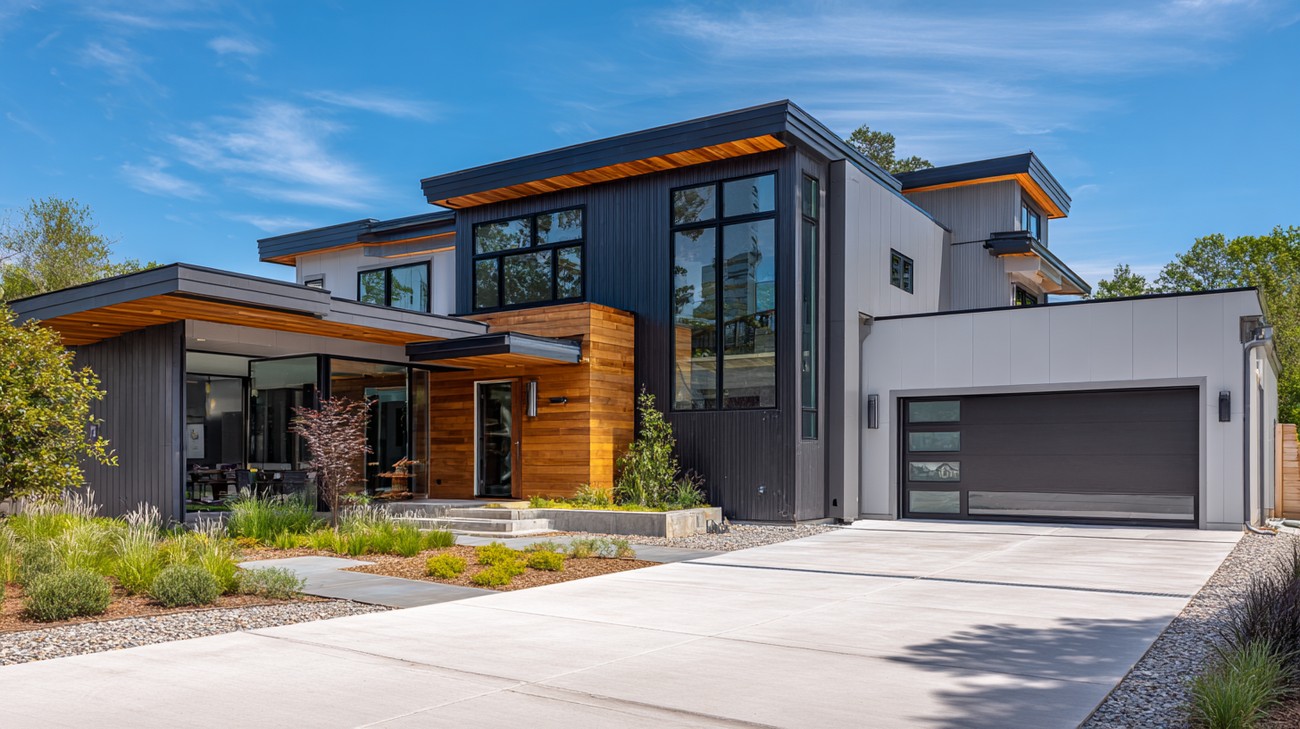
Frequently Asked Questions about James Hardie Siding Styles
How does James Hardie Lap Siding differ from other siding styles?
James Hardie Lap Siding, also known as HardiePlank®, is celebrated for its versatile and traditional appearance. Unlike other siding styles, HardiePlank® is designed to mimic the look of natural wood planks while providing enhanced durability and weather resistance. It is available in several finishes, including smooth and textured, and can be painted in any of James Hardie’s range of color options. This style is particularly favored for its timeless appeal and adaptability to a variety of home styles, from contemporary to classic.
Can James Hardie siding styles enhance my home’s curb appeal?
Absolutely, choosing the right James Hardie siding style can significantly boost your home's curb appeal. The wide array of styles and colors offered by James Hardie allows homeowners to create a unique and attractive exterior that stands out. Whether you opt for the sophisticated look of HardiePlank® Lap Siding or the rustic charm of HardieShingle® Siding, these styles are designed not only for aesthetics but also to withstand harsh weather, keeping your home looking beautiful for years. Customizing the siding to complement other architectural elements of your home can provide a cohesive and polished look.
Are there eco-friendly James Hardie siding options?
Yes, James Hardie siding styles are designed with sustainability in mind. The company uses sustainable manufacturing processes and materials, such as locally-sourced sand, cement, and cellulose fibers, which contribute to a lower environmental impact compared to some other siding options. Additionally, the durability and longevity of James Hardie siding mean fewer resources are used over time, as replacements are not needed as frequently. This makes James Hardie siding an environmentally-responsible choice for homeowners seeking to reduce their carbon footprint.
How do I decide on the best James Hardie siding style for my home?
Choosing the best James Hardie siding style largely depends on your home’s architectural style, your aesthetic preferences, and your budget. First, consider the architectural design of your home; some styles, like HardieShingle®, might complement traditional homes, while HardiePanel® Vertical Siding can add a modern twist to a contemporary design. Look at the color palettes and textures available to see what aligns with your vision. Visiting homes with James Hardie siding in your neighborhood or checking out online galleries can provide inspiration and help you visualize the outcome. Additionally, consulting with a professional siding contractor can give you further insights into the best choices for your specific needs.
Are there specific maintenance requirements for different James Hardie siding styles?
Yes, each James Hardie siding style may have slightly different maintenance requirements. In general, these sidings are low maintenance compared to traditional wood siding. You’ll want to conduct regular cleanings to remove dirt and debris, which can typically be accomplished with a garden hose or a gentle pressure wash. It's also essential to keep an eye on caulking to ensure it's intact and functioning properly to avoid water infiltration. Checking for any chipped paint and touching up as necessary will help preserve the siding's appearance and integrity. Thanks to the robust nature of James Hardie’s materials, these routine tasks ensure your siding remains in excellent condition for years.
Does the color of James Hardie siding styles fade over time?
James Hardie siding styles are available with ColorPlus® Technology, which involves applying multiple coats of a proprietary finish, baked on to create a strong bond that resists chipping, peeling, and cracking. This technology provides a finish that helps maintain the vibrancy of the color for an extended period. While no exterior product is entirely impervious to fading, ColorPlus® Technology significantly reduces the impact of UV exposure, meaning your home’s exterior color will stay true for much longer compared to traditional paint finishes. For those who prefer to paint their siding, James Hardie products are also designed to hold paint well, making them a durable and visually enduring choice.
Is it possible to mix and match different James Hardie siding styles?
Yes, mixing and matching different James Hardie siding styles is a popular way to add architectural interest and uniqueness to your home’s exterior. Combining styles, such as pairing HardiePlank® Lap Siding with HardieShingle® Siding, can create a visually dynamic appearance while highlighting architectural features like gables and porches. This approach allows homeowners to accentuate certain areas of their home, add dimension, or even create a seamless transition between different sections of the house. Consulting a design professional can aid in choosing complementary styles and colors that work well together and suit the overall look you envision for your home.

Pros & Cons of james hardie siding styles
Pros
Durability and Longevity
One of the standout features of James Hardie siding styles is their exceptional durability and longevity. Made from fiber cement, this siding is known to withstand harsh weather conditions, including heavy rain, snow, and hail. This durability translates to a longer lifespan compared to other siding options, which means fewer repairs and replacements over the years.
Versatility in Design
James Hardie offers a wide range of siding styles, making it easy to find one that complements the aesthetic of your home. Whether you prefer a classic, modern, or rustic look, there is likely a design that will match your vision. This versatility allows homeowners to experiment with different textures, patterns, and colors to achieve their desired curb appeal.
Fire Resistance
One of the unique pros of James Hardie siding styles is their high level of fire resistance. Fiber cement siding is non-combustible, providing an added layer of protection to homes, particularly in areas prone to wildfires. This feature not only enhances safety but could also contribute to lower homeowners insurance premiums.
Low Maintenance
Compared to wood and other traditional siding materials, James Hardie siding requires minimal maintenance. It does not rot or become warped with extreme temperature changes. A simple power wash a couple of times a year is usually sufficient to keep it looking as good as new.
Aesthetic Appeal
The broad spectrum of colors and styles offers a significant aesthetic advantage. James Hardie siding can mimic the look of wood, stucco, or other materials without the downsides associated with those options. Furthermore, the ColorPlus Technology ensures that colors remain vibrant longer, reducing the need for frequent repainting.
Environmental Friendliness
James Hardie siding is considered more environmentally friendly compared to vinyl siding. It is made from natural materials like cement, sand, and cellulose fibers, which reduce its environmental footprint. Moreover, the longevity and reduced maintenance requirements contribute to less waste and fewer resources used over time.
Cons
Cost
While James Hardie siding offers numerous benefits, it comes with a higher upfront cost compared to other siding materials. The initial investment can be prohibitive for some homeowners, especially those on a tight budget. However, it's important to weigh the initial cost against the long-term benefits such as durability and reduced maintenance.
Installation Complexity
Installing James Hardie siding requires skill and precision, often necessitating professional installation. This adds to the overall cost and can limit options for those interested in a DIY approach. Improper installation may lead to performance issues, negating some of the material’s benefits.
Weight
Being heavier than vinyl or wood siding, James Hardie siding can be more challenging to handle. This places additional demands on the structure of the home, and in some cases, may require additional support or reinforcement, especially in older homes not originally designed for it.
Limited R-value
An often-overlooked drawback is that James Hardie siding has a relatively low R-value, meaning it provides limited insulation by itself. Homeowners interested in enhancing energy efficiency may need to invest in additional insulation solutions, adding to the overall cost and effort.
Potential for Cracking
Despite its durability, James Hardie siding may crack under certain extreme conditions, such as rapid freezing and thawing cycles. These cracks can compromise its aesthetic and protective qualities and might require repair sooner than expected.
Maintenance of Paint Finish
Although James Hardie siding with ColorPlus Technology is designed to maintain its color longer, eventual repainting is likely, especially in locations with intense sunlight exposure. While less frequent than wood siding, it’s still a factor to consider, particularly for budget-conscious homeowners.
Compatibility Concerns
James Hardie siding may not be compatible with all home designs or historical properties that require specific aesthetic preservation. This can limit its use in specialized restoration projects or neighborhoods with strict design guidelines.

Cost Breakdown
When considering James Hardie siding for your home, it's essential to understand the various costs associated with the different styles and options available. This breakdown will help you gain clarity on what you might expect to spend, factors that can influence pricing, how basic options compare to premium products, potential hidden costs, and strategies to save money.
Typical Price Ranges
James Hardie offers a variety of siding styles, including HardiePlank® lap siding, HardieShingle® siding, HardiePanel® vertical siding, and HardieTrim® boards. The typical price range for these siding styles can vary significantly based on the type chosen. Generally, you can expect:
- HardiePlank® Lap Siding: $8 to $12 per square foot installed.
- HardieShingle® Siding: $10 to $14 per square foot installed.
- HardiePanel® Vertical Siding: $9 to $11 per square foot installed.
- HardieTrim® Boards: $2 to $5 per linear foot installed.
These costs include materials and labor but may fluctuate based on various factors.
Factors That Affect Cost
Several factors can impact the overall cost of James Hardie siding:
Material Options: The choice of siding style, texture, and finish will affect the cost, with some options being more expensive than others due to their aesthetic appeal or manufacturing complexity.
Installation Complexity: The architectural design of your home, such as multiple stories or complex angles, can increase labor costs due to the more challenging installation process.
Geographic Location: Pricing can vary greatly depending on your location. Areas with a higher cost of living typically have higher labor costs.
Preparation and Repairs: If your home requires additional preparation work, such as the removal of old siding or repairs to the exterior walls, costs will increase.
Customization: Special color options or custom finishes from James Hardie can lead to higher costs as compared to standard factory finishes.
Cost Comparison: Budget vs. Premium Options
James Hardie offers both budget-friendly and premium siding options. Budget choices usually involve standard textures and limited color options, while premium selections may include more intricate designs and custom colors.
- Budget Option: Basic HardiePlank® siding with a standard factory paint might range from $8,000 to $15,000 for a typical 2,000-square-foot home.
- Premium Option: Opting for HardieShingle® siding with custom finishes and detailed trim can push costs to the $20,000 to $35,000 range for the same size home.
Hidden Costs to Consider
When budgeting for your James Hardie siding, be aware of potential hidden costs:
- Permits and Inspections: Local government fees for building permits and necessary inspections can add an additional $500 to $1,000.
- Scaffolding and Safety Equipment: For taller homes, scaffolding might be necessary, adding to labor costs.
- Waste Disposal: The removal and disposal of old siding materials and waste can add another $500 to $1,000.
Ways to Save Money
If you're seeking to reduce costs, consider these strategies:
Off-Season Installation: Arrange your siding installation during the off-season (typically late fall or winter) when contractors may offer discounts due to lower demand.
Multiple Quotes: Obtain several estimates from licensed contractors to ensure you receive competitive pricing.
Factory Finishes: Choose factory-painted siding over custom on-site painting to avoid additional labor costs.
Energy Efficiency Incentives: Check for local or federal incentives that may provide tax credits or rebates for energy-efficient siding products.
By understanding these cost factors and exploring money-saving options, you can find a James Hardie siding style that fits both your budget and aesthetic preferences, ensuring a fruitful investment in your home's exterior.
Buyer's Guide: What to Look For
James Hardie siding, renowned for its durability and aesthetic appeal, is an excellent choice for homeowners looking to enhance their home's exterior. As you embark on selecting the perfect style, it's essential to consider various factors and differentiate between indispensable features and those that are merely beneficial. Below is a comprehensive guide to help you make an informed decision.
Key Factors to Consider
1. Climate Compatibility:
James Hardie siding is designed to withstand various climate conditions, but it's crucial to choose a style that aligns with your local environment. For instance, products in the HardieZone® system are specifically engineered for specific climates, offering enhanced protection against moisture, wind, and temperature fluctuations.
2. Aesthetic Appeal:
James Hardie offers a plethora of styles, including HardiePlank® Lap Siding, HardiePanel® Vertical Siding, HardieShingle® Siding, and HardieTrim® Boards, each available in various textures and colors. Consider the architectural style of your home and your personal taste to select a siding that complements and enhances its appearance.
3. Maintenance Requirements:
James Hardie siding is low maintenance compared to traditional wood siding, but certain styles may require more upkeep due to intricate designs. Understand the cleaning and maintenance needs of the style you choose to ensure it fits your lifestyle and future plans.
4. Energy Efficiency:
While not all siding styles are inherently energy efficient, certain options can improve your home's insulation. Check the R-value and ensure adequate insulation to potentially reduce energy bills.
5. Warranty and Lifespan:
James Hardie products typically come with a 30-year limited transferable warranty, showcasing their long-term durability. Verify the warranty details for different styles and ensure your installation complies with manufacturer guidelines to prevent voiding the warranty.
Must-Have vs. Nice-to-Have Features
Must-Have Features:
- Weather Resistance: Essential for the longevity and durability of your siding, ensuring your home is protected from the elements.
- Fire Resistance: James Hardie siding is non-combustible, an important feature for safety and potential insurance savings.
- ColorPlus® Technology: A must-have for long-lasting color with minimal fading and maintenance.
Nice-to-Have Features:
- Customizable Designs: While not vital, having the ability to custom tailor the look of your siding to match your home's specific design can be a significant aesthetic advantage.
- Local Code Compliance: Ensures your siding is compliant with local building codes for easy approval and inspection.
Red Flags to Avoid
- Damaged or Warped Panels: Ensure that no panels have damage or warping, as this could compromise the siding’s integrity.
- Lack of Certification or Warranty: Choosing siding without proper certification or warranty can lead to challenges in case of future damage.
- Inadequate Installation Offers: Improper installation can void warranties and diminish performance, rather than save costs.
Questions to Ask Before Buying
- What is the specific James Hardie style most compatible with my local climate?
- How does this siding style complement the architecture of my home?
- What are the maintenance requirements and associated costs?
- Are there local contractors experienced in installing James Hardie products?
- What is the total cost including installation, and are there financing options available?
How to Spot Quality
1. Look for Certification and Compliance:
Ensure that the siding is certified by James Hardie, verifying its authenticity and quality.
2. Check for Even Finish and Color:
The ColorPlus® Technology should provide uniform color application without visible defects.
3. Assess Texture and Material Thickness:
Quality siding will have a consistent texture and be of adequate thickness to provide durability and protection.
4. Verify Installation Expertise:
Professionally installed siding not only ensures warranty compliance but also contributes to your home's long-term aesthetics and performance. Look for certified installers with positive reviews and a solid reputation.
By keeping these considerations in mind, you'll be well-equipped to select a James Hardie siding style that best suits your home and provides lasting satisfaction.
Summary
Choosing the right exterior for your home is a big decision, and James Hardie siding styles offer a wide range of options to suit any architectural preference or personal taste. Whether you favor a traditional look with their classic lap siding or want to make a bold statement with their vertical designs, there's a style to match your vision. The versatility and durability of James Hardie products make them an attractive choice, providing both aesthetic appeal and long-lasting protection for your home.
James Hardie siding styles have earned a reputation for their resilience against harsh weather, pests, and even fire, which adds an invaluable layer of peace of mind to your home investment. Not only are these materials crafted to withstand the test of time, but they also offer low-maintenance requirements, making them a practical option for homeowners who want both style and convenience. Their ColorPlus Technology ensures vibrant colors that resist fading and help maintain your home's curb appeal over the years.
Ultimately, exploring James Hardie siding styles opens up a world of possibilities for personalization and protection. As you ponder which style best complements your home, consider not just the visual impact but also the long-term benefits these siding options provide. With James Hardie, you're investing in a trusted brand that combines aesthetic versatility with cutting-edge durability, ensuring your home remains beautiful and safeguarded for decades to come.
About US Quality Construction of Lexington
US Quality Construction of Lexington, located in the heart of Kentucky, proudly brings over a decade of experience and expertise to residential and commercial projects throughout the region. As a locally owned and operated business, we are passionate about contributing to our community by providing top-notch construction services that combine innovative solutions with time-honored craftsmanship. Whether you're envisioning a home renovation, a custom build, or a commercial upgrade, our dedicated team of professionals is committed to delivering excellent results with a personalized approach. At US Quality Construction of Lexington, we value integrity, quality, and customer satisfaction above all, ensuring that every project not only meets but exceeds your expectations.
Tags: james hardie, siding styles, home renovation,
